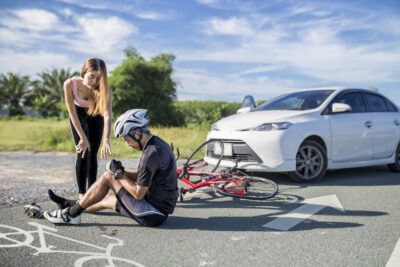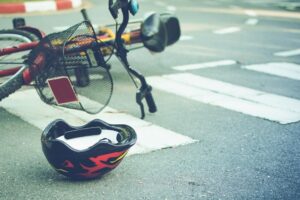
A bicycle accident can happen when you least expect it. Whether you’re a cyclist who’s been hit by a car or a driver involved in a crash with a bike, understanding bike accident liability is critical to recovering compensation.
Who is liable in a bike lane accident depends on the circumstances of the collision. Bike accident claims can be complicated, especially if responsibility is disputed. If you’ve been involved in a bike crash, an Atlanta bicycle accident lawyer can help gather evidence, prove liability, and fight for a fair settlement.
Who Is at Fault in a Bike Lane Accident?
Liability in a bike lane accident depends on the circumstances of the crash. Drivers are supposed to yield to cyclists in bike lanes, but cyclists also have a responsibility to obey traffic laws.
Drivers are often found at fault when they drift into a bike lane, make unsafe turns, or open a car door into the path of a cyclist. However, cyclists can also be at fault if they violate traffic laws, ignore signals, or weave unpredictably into traffic.
Ultimately, the party that acted negligently will be held responsible for the crash. In some cases, both the driver and the cyclist may share fault.
Get the strong arm
Is the Driver Always at Fault for Hitting a Cyclist?
Not necessarily. While drivers are often at fault in bike lane accidents, cyclists also have legal responsibilities. A cyclist who engages in the following types of behavior can be held liable:
- Swerving out of the bike lane
- Failing to obey traffic lights or stop signs
- Riding against the flow of traffic
- Engaging in distracted riding
What Factors Determine Liability in a Bike Lane Accident?
Several factors come into play when determining liability in a bicycle accident, such as:
- Traffic laws: Violations of traffic laws (like running a red light or failing to yield) can indicate fault.
- Right of way: If a cyclist or driver fails to yield to the rightful user of the road or intersection, they may be held liable.
- Location of the bike lane: Drivers must respect dedicated bike lanes. Entering them illegally or without signaling can count as negligence.
- Driver and cyclist behavior: Reckless driving, speeding, distracted driving, or riding without lights at night can all qualify as negligence.
- Witness statements and surveillance: Eyewitness accounts or video footage can help confirm what happened.
- Police reports: Files from police often contain details about the crash and any citations that were issued, which can help establish liability.
How Does Comparative Fault Work in Georgia?
Georgia enforces a modified comparative fault rule. Under this system, you can still recover compensation if you were less than 50% at fault for a bike accident. However, your compensation will be reduced by your percentage of fault.
For example, if your damages total $10,000 and you’re found to be 20% at fault, you’d receive $8,000.
What Types of Evidence Do You Need to Prove Fault in a Bike Accident Case?
To build a strong bike accident claim, you’ll need compelling evidence. This may include:
- Photographs of the scene: Pictures of the bike, vehicle, injuries, road signs, and skid marks can show how the accident occurred.
- Surveillance or dash cam footage: These videos can depict the crash or the events leading up to it.
- Witness statements: Independent witnesses can offer objective accounts that support your version of events.
- Medical records: These files will attest to the nature and severity of your injuries.
- Police reports: Officers may note who appeared to be at fault and if any citations were issued.
- Expert testimony: Accident reconstruction experts can help establish how the collision happened and who was likely at fault.
How Much Compensation Can I Get for a Bike Accident?
Bicycle accident settlements can range from a few thousand dollars to six or seven-figure sums. The amount you receive will depend on factors such as medical expenses, property damage, and lost wages.
Why Do I Need a Bike Accident Lawyer?
Bike accident cases can be complex. A bicycle accident lawyer can:
- Investigate the accident and gather evidence
- Prove liability
- Negotiate with insurance companies on your behalf
- Take your case to court (if necessary)
Without a lawyer, you may be pressured into accepting a low settlement or even blamed for the crash. An attorney can significantly improve your chances of a successful outcome.
Common Causes of Bike Lane Accidents
Bike lane accidents often result from negligent behavior or failure to observe traffic laws. Common causes include:
- Distracted driving
- Drivers veering into bike lanes
- Dooring accidents (when a parked driver opens a door into a cyclist’s path)
- Right-turn collisions at intersections
- Speeding
- Cyclists riding against traffic
- Poor visibility or riding at night without lights
- Road hazards like potholes or debris
What to Do After a Bike Lane Accident
If you’re involved in a bike lane accident, it’s important to take these steps:
- Call 911 and report the crash.
- Document the scene by taking photos of any property damage or injuries, as well as the scene of the crash.
- Exchange information with the driver, including your insurance and license numbers.
- Get contact information from any available witnesses.
- Visit a doctor, even if you feel fine.
- Avoid admitting fault or making statements that could be used against you.
- Contact a bike accident lawyer as soon as possible.
Contact a Bicycle Accident Lawyer
Bike lane accidents can lead to serious injuries and sky-high medical bills. If you’ve been hurt while cycling, a bicycle accident attorney from John Foy & Associates can provide guidance and help you pursue the compensation you need to move forward.
Take advantage of The Strong Arm™ of Georgia, including our team’s 350-plus years of combined legal experience, by scheduling a free consultation today.
(404) 400-4000 or complete a Free Case Evaluation form

